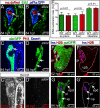Loss of Dnmt1 catalytic activity reveals multiple roles for DNA methylation during pancreas development and regeneration
- PMID: 19631206
- PMCID: PMC2759669
- DOI: 10.1016/j.ydbio.2009.07.017
Loss of Dnmt1 catalytic activity reveals multiple roles for DNA methylation during pancreas development and regeneration
Abstract
Developmental mechanisms regulating gene expression and the stable acquisition of cell fate direct cytodifferentiation during organogenesis. Moreover, it is likely that such mechanisms could be exploited to repair or regenerate damaged organs. DNA methyltransferases (Dnmts) are enzymes critical for epigenetic regulation, and are used in concert with histone methylation and acetylation to regulate gene expression and maintain genomic integrity and chromosome structure. We carried out two forward genetic screens for regulators of endodermal organ development. In the first, we screened for altered morphology of developing digestive organs, while in the second we screed for the lack of terminally differentiated cell types in the pancreas and liver. From these screens, we identified two mutant alleles of zebrafish dnmt1. Both lesions are predicted to eliminate dnmt1 function; one is a missense mutation in the catalytic domain and the other is a nonsense mutation that eliminates the catalytic domain. In zebrafish dnmt1 mutants, the pancreas and liver form normally, but begin to degenerate after 84 h post fertilization (hpf). Acinar cells are nearly abolished through apoptosis by 100 hpf, though neither DNA replication, nor entry into mitosis is halted in the absence of detectable Dnmt1. However, endocrine cells and ducts are largely spared. Surprisingly, dnmt1 mutants and dnmt1 morpholino-injected larvae show increased capacity for pancreatic beta cell regeneration in an inducible model of pancreatic beta cell ablation. Thus, our data suggest that Dnmt1 is dispensable for pancreatic duct or endocrine cell formation, but not for acinar cell survival. In addition, Dnmt1 may influence the differentiation of pancreatic beta cell progenitors or the reprogramming of cells toward the pancreatic beta cell fate.
Figures






Similar articles
-
Zebra fish Dnmt1 and Suv39h1 regulate organ-specific terminal differentiation during development.Mol Cell Biol. 2006 Oct;26(19):7077-85. doi: 10.1128/MCB.00312-06. Mol Cell Biol. 2006. PMID: 16980612 Free PMC article.
-
Uhrf1 and Dnmt1 are required for development and maintenance of the zebrafish lens.Dev Biol. 2011 Feb 1;350(1):50-63. doi: 10.1016/j.ydbio.2010.11.009. Epub 2010 Nov 30. Dev Biol. 2011. PMID: 21126517 Free PMC article.
-
DNMT1 represses p53 to maintain progenitor cell survival during pancreatic organogenesis.Genes Dev. 2013 Feb 15;27(4):372-7. doi: 10.1101/gad.207001.112. Genes Dev. 2013. PMID: 23431054 Free PMC article.
-
DNMT1: catalytic and non-catalytic roles in different biological processes.Epigenomics. 2022 May;14(10):629-643. doi: 10.2217/epi-2022-0035. Epub 2022 Apr 12. Epigenomics. 2022. PMID: 35410490 Review.
-
An insight into the various regulatory mechanisms modulating human DNA methyltransferase 1 stability and function.Epigenetics. 2012 Sep;7(9):994-1007. doi: 10.4161/epi.21568. Epub 2012 Aug 16. Epigenetics. 2012. PMID: 22894906 Free PMC article. Review.
Cited by
-
A monocarboxylate transporter required for hepatocyte secretion of ketone bodies during fasting.Genes Dev. 2012 Feb 1;26(3):282-93. doi: 10.1101/gad.180968.111. Genes Dev. 2012. PMID: 22302940 Free PMC article.
-
Zebrafish as a Useful Model System for Human Liver Disease.Cells. 2023 Sep 11;12(18):2246. doi: 10.3390/cells12182246. Cells. 2023. PMID: 37759472 Free PMC article. Review.
-
UHRF1 overexpression drives DNA hypomethylation and hepatocellular carcinoma.Cancer Cell. 2014 Feb 10;25(2):196-209. doi: 10.1016/j.ccr.2014.01.003. Epub 2014 Jan 30. Cancer Cell. 2014. PMID: 24486181 Free PMC article.
-
UHRF1 phosphorylation by cyclin A2/cyclin-dependent kinase 2 is required for zebrafish embryogenesis.Mol Biol Cell. 2012 Jan;23(1):59-70. doi: 10.1091/mbc.E11-06-0487. Epub 2011 Nov 9. Mol Biol Cell. 2012. PMID: 22072796 Free PMC article.
-
Identification of Annexin A4 as a hepatopancreas factor involved in liver cell survival.Dev Biol. 2014 Nov 1;395(1):96-110. doi: 10.1016/j.ydbio.2014.08.025. Epub 2014 Aug 29. Dev Biol. 2014. PMID: 25176043 Free PMC article.
References
-
- Beis D, Bartman T, Jin SW, Scott IC, D'Amico LA, Ober EA, Verkade H, Frantsve J, Field HA, Wehman A, Baier H, Tallafuss A, Bally-Cuif L, Chen JN, Stainier DY, Jungblut B. Genetic and cellular analyses of zebrafish atrioventricular cushion and valve development. Development. 2005;132:4193–204. - PubMed
-
- Biemar F, Argenton F, Schmidtke R, Epperlein S, Peers B, Driever W. Pancreas development in zebrafish: early dispersed appearance of endocrine hormone expressing cells and their convergence to form the definitive islet. Dev Biol. 2001;230:189–203. - PubMed
-
- Bird AP, Wolffe AP. Methylation-induced repression--belts, braces, and chromatin. Cell. 1999;99:451–4. - PubMed
-
- Bostick M, Kim JK, Esteve PO, Clark A, Pradhan S, Jacobsen SE. UHRF1 plays a role in maintaining DNA methylation in mammalian cells. Science. 2007;317:1760–4. - PubMed
Publication types
MeSH terms
Substances
Grants and funding
LinkOut - more resources
Full Text Sources
Molecular Biology Databases

